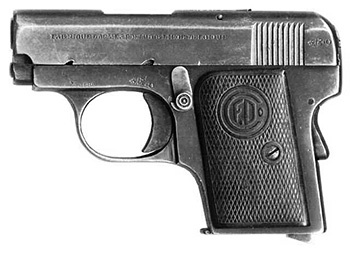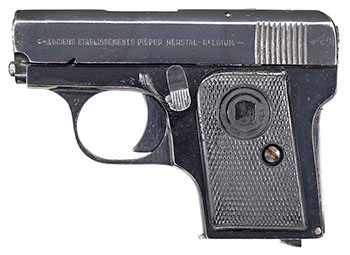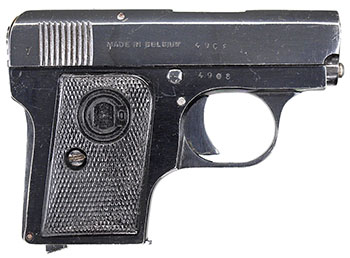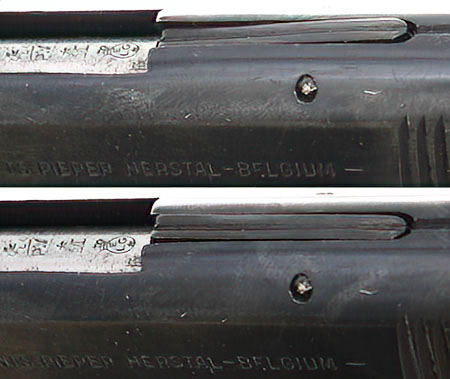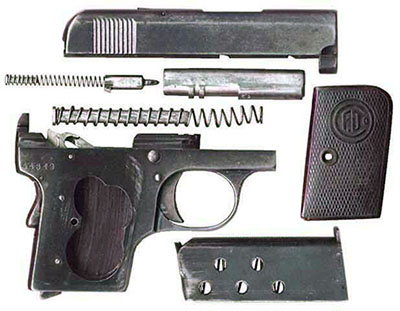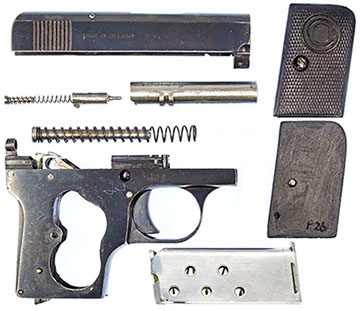 |
|||||||||||||||||||||||||||||||||||||||||||||||||||||||||||||||||||||||||||||||||||||||||||||||||||||||||||||
|
The Pieper New Model 6.35mm Pistol by Ed Buffaloe
The Pieper New Model is based on the design of the second variation of the Delu pistol. In his 2008 article, Dirk Ziesing appropriately refers to the Pieper New Model as the Pieper-Delu. He relates: “The simplified name ‘Delu’ is a synonym for ‘Fabrique d'armes Delu Félix et Cie’. Its first address was Rue Large Voie 38 in Herstal. Its trademark consisted of the letters ‘Co FD’ in a circle.” The first variation Delu pistol was patented by Félix Delu in Belgium in 1921. The first variation Delu has an internal hammer, a transfer bar that runs on the right side only, and no grip safety. Both Delu variants have a top-mounted extractor and look nearly identical externally. However, they are completely different internally. The second varition Delu pistol is quite similar to the 1906 FN Browning: striker-fired, with a Browning-style stirrup-shaped transfer bar, and a grip safety. I am not aware if a patent was ever filed for the second variant of the Delu pistol, and I have been unable to determine exactly what years it was manufactured, but production almost certainly ceased before the beginning of World War II
I do not have an opinion as to which of these scenarios is correct. Dirk Ziesing clearly favors the second, and he may well be correct. The important point is that A.E.P. took leftover Delu parts, designed and manufactured whatever additional parts were needed, and assembled them into the Pieper New Model pistols. Michel Druart, in his book Bayard, displays 1946 dated A.E.P. design drawings for the grip safety lever, the barrel, and the magazine: each had handwritten notes regarding revisions made in 1951.
The Pieper New Model is marked on the left side of the slide in all capital sans-serif characters: ANC. ETABL. PIEPER HERSTAL BELGIUM or — ANCIENS ETABLISSEMENTS PIEPER HERSTAL-BELGIUM — A few early guns have no caliber marking, but most later guns are stamped “6.35 BR” on the left side of the frame ; this mark is often poorly stamped. The right side of the slide is marked in all capital sans-serif characters: MADE IN BELGIUM Serial numbers are on the right side and are stamped, on both the frame and the slide, above the trigger. A few guns have no serial number on the slide. Various parts, including the frame, are often stamped with assembly numbers. These are usually on the left bow of the trigger guard, and the right side of the slide, behind the serrations. Early guns have ten triangular-cut vertical slide serrations on both sides. Some later guns have eight or seven. Some of the late guns appear to have their seven serrations plunge-milled instead of being a triangular-cut.
I have been unable to locate any advertisements that might indicate when the New Model was marketed. It is marked “MADE IN BELGIUM” on the right side, in English, as if the company intended to market the gun in the U.S. In this regard, Michel Druart relates a story told by a former employee of Pieper that a large number of Pieper New Model pistols were shipped to the U.S., arrived without strikers installed and, hence, were returned. Serial number 4158 is stamped with the GECO retail mark of the Gustav Genschow company. I have been unable to locate a Geco catalog that includes the Pieper New Model, but the gun clearly saw some distribution in Germany. It could have been legally imported into the U.S. until 1968. We must consider the possibility that the gun received very limited distribution during the last years of A.E.P., as well as the possibility that the final stock of pistols may have been liquidated during the bankruptcy process which, according Michel Druart, lasted from 1954 until 1957. I have recorded serial numbers from 62 through 8893. At this time I suggest that less than 10,000 were made. There is a purported Pieper New Model that was sold in recent years with the serial number 1. I believe it to be a fake, or to at least have fake markings, or markings that were tampered with, because its proof marks include the Perron which was last used in Liège around 1924. In addition, the right side of the gun is marked “Browning’s Patent” unlike any other known Pieper New Model, and the left side slide inscription is on two lines. Please write to me, if you have a Pieper New Model and send photographs.*
Field Stripping the Pieper New Model (Pieper-Delu)
*Write to edbuffaloe@unblinkingeye.com |
|||||||||||||||||||||||||||||||||||||||||||||||||||||||||||||||||||||||||||||||||||||||||||||||||||||||||||||
|
|||||||||||||||||||||||||||||||||||||||||||||||||||||||||||||||||||||||||||||||||||||||||||||||||||||||||||||
|
Copyright 2022 by Ed Buffaloe. All rights reserved. |
|||||||||||||||||||||||||||||||||||||||||||||||||||||||||||||||||||||||||||||||||||||||||||||||||||||||||||||
|
|
|||||||||||||||||||||||||||||||||||||||||||||||||||||||||||||||||||||||||||||||||||||||||||||||||||||||||||||
